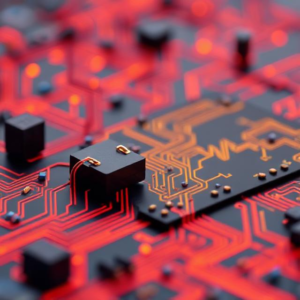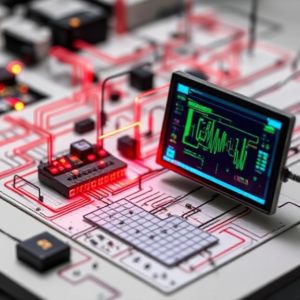Applying Simulations to Solve Real-World Circuit Problems
In modern electrical engineering, solving circuit problems is essential for the design and analysis of electrical systems. While traditional methods like theoretical calculations and manual analysis have been used for decades, the application of simulations has significantly enhanced the ability to solve complex real-world circuit problems efficiently and accurately. This approach involves using specialized software to model, simulate, and analyze electrical circuits under various conditions, offering a practical and cost-effective solution.

What are Simulations in Circuit Design?
Circuit simulation refers to the process of using software tools to model and test electrical circuits before they are physically built. These tools simulate the behavior of the circuit in real-time, providing insights into how components interact under different scenarios. Engineers can use these simulations to observe how voltage, current, power, and other electrical quantities change across the circuit. Popular simulation tools include SPICE (Simulation Program with Integrated Circuit Emphasis), MATLAB, and PSpice, among others.
Simulations allow engineers to test a wide range of circuit configurations without needing to build the actual hardware first. This process helps identify potential problems, optimize designs, and reduce development time and costs.
Benefits of Circuit Simulation
-
Cost-Effective: Building physical prototypes for every possible circuit design can be expensive and time-consuming. With simulations, engineers can quickly test different designs without the need for expensive hardware.
-
Time-Saving: Simulations allow for rapid iteration, making it possible to test a variety of circuit designs in a fraction of the time it would take to build each one.
-
Risk Reduction: By using simulations, engineers can identify design flaws and issues early in the process, minimizing the risk of failures during the final build.
-
Detailed Insights: Simulations provide detailed insights into a circuit’s behavior, including transient analysis (how the circuit responds over time), frequency analysis (how the circuit behaves at different frequencies), and thermal analysis (how components heat up).
-
Optimized Design: Simulation tools often include optimization algorithms, which help engineers fine-tune their circuit design to achieve the desired performance while minimizing costs.
Types of Circuit Problems Solved Through Simulations
Simulations can address a wide range of circuit problems, including:
-
Component Sizing and Selection: When designing a circuit, selecting the right components (resistors, capacitors, transistors, etc.) is critical. Simulations can quickly assess how different components affect the circuit’s performance, helping to choose the right values and specifications for the design.
-
Thermal Management: In power circuits or circuits that involve high currents, overheating can be a problem. Simulations can model heat distribution within the circuit to ensure that components are not exposed to temperatures beyond their operating limits.
-
Noise Analysis: Circuits can be affected by electrical noise, which can degrade performance or cause malfunctions. Simulation software can simulate noise sources and help engineers design circuits with better immunity to interference.
-
Transient Analysis: For circuits that involve sudden changes in voltage or current, transient analysis is crucial. Simulations can show how a circuit will respond to these sudden changes and help design more robust systems.
-
Signal Integrity: In high-speed circuits, signal integrity becomes a key concern. Simulations can identify potential issues like signal distortion, crosstalk, and reflections, which can negatively impact performance.
Steps in Using Simulations for Circuit Design
-
Create the Circuit Model: The first step in any simulation is to create a model of the circuit. This is done using the simulation software, where each component (resistor, capacitor, transistor, etc.) is placed on a virtual schematic.
-
Set Simulation Parameters: Once the model is created, the next step is to define the parameters for the simulation. These include power supply values, input signals, temperature, and other conditions that might affect the circuit’s performance.
-
Run the Simulation: After the circuit is set up and the parameters defined, the simulation is run. The software will calculate how the circuit behaves under the given conditions.
-
Analyze the Results: Once the simulation completes, the results are analyzed. Engineers will look at different parameters like voltage drops, current flow, power consumption, and any other metrics that are important for the circuit’s design.
-
Iterate and Optimize: Based on the results, changes may be made to the design to improve performance or address issues. The process is repeated, refining the design with each iteration.
Real-World Examples of Circuit Simulations
-
Power Electronics: In power electronics, simulations are essential for designing circuits that convert and control electrical power efficiently. Engineers use simulations to optimize the performance of power supplies, motor drives, and inverters, ensuring they meet strict efficiency and reliability standards.
-
Consumer Electronics: In the design of consumer electronics, such as smartphones and laptops, simulations are used to test everything from signal processing circuits to battery charging circuits. This ensures that the final product works as intended and is safe for consumers.
-
Automotive Circuit Design: In modern vehicles, complex circuits are used for everything from controlling engines to managing electrical systems. Simulations are employed to ensure that these circuits operate efficiently and reliably under varying environmental conditions, such as temperature fluctuations and electromagnetic interference.
-
Telecommunications: In telecommunications, simulations are used to design and test circuits that carry signals over long distances. This includes analyzing the effects of noise, signal attenuation, and interference, as well as optimizing the design for maximum data transmission rates.
Challenges of Using Simulations
While simulations offer significant benefits, they are not without challenges. One challenge is the accuracy of the simulation results, which depends on the quality of the models used for the components. If the components are not accurately modeled, the simulation results may not reflect real-world behavior. Additionally, simulations can become computationally expensive for very complex circuits, requiring high-performance computing resources.
Another challenge is that simulations typically focus on idealized conditions. Real-world factors like manufacturing tolerances, component aging, and environmental variations might not always be accurately reflected in simulations.
Conclusion
In conclusion, simulations are an indispensable tool in solving real-world circuit problems. They allow engineers to design, analyze, and optimize electrical circuits in a cost-effective, efficient, and risk-reducing manner. By offering detailed insights into the behavior of circuits, simulations enable engineers to make informed decisions during the design phase, resulting in more reliable and efficient electrical systems. Despite some challenges, the advantages of using simulations far outweigh the limitations, making them a key component of modern circuit design and analysis.












